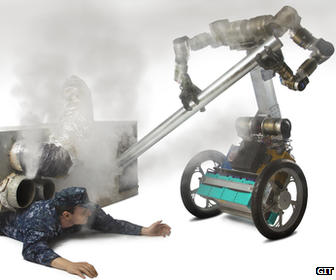Future tech: Smart fabrics and other forecasts
- Published
Part two of the BBC News Website's technology summit, focusing on the future
Technology keeps surprising us, both by how quickly it moves and how slowly it develops. Where are our flying cars? Where are our household robots?
Innovations don't always evolve the way we think, but based on what we do know it is possible to make a few safe-bet prophecies.
In the video above a group of tech insiders predict the future of apps, gesture controls and the giant gadget-makers. And in the article below we take a look at what comes next with the connected world, smart materials and robotics.
It seems like a perfect house. The building sounds the alarm every morning. It cooks the food, it keeps the floors clean. It repairs itself.
The smart home was envisaged more than 60 years ago by science fiction author Ray Bradbury in his Martian Chronicles. His house had just one flaw: the family was long-dead while the house just carried on.
Now the latest advances in technology are starting to bridge the gap between 21st century reality and Bradbury's fiction (minus the nuclear war).
The internet of things, in which physical objects are connected to the web, will make our environment more intelligent than ever.
In 2012 we saw smart thermostats tweak room temperatures to suit owners' habits; plants post to Twitter that they needed watering; and cars alert each other to traffic jams.
AlphaDog can walk for 20 miles without a break - video courtesy Darpa
This is just a tiny taste of what's to come, says Steve Lewis from Living PlanIT, a company aiming to make entire cities smart.
"We are developing a city in Portugal that will ultimately deploy tens of millions of collaborating sensors in buildings, transportation, energy, water and waste systems, public lighting and a myriad of other sensors," he says.

The US Navy is funding a project aiming to build a robot that could be a first-of-its-kind teammate for its personnel
Similar efforts are underway in the UK, the Netherlands, China and Brazil, he adds.
Already, more than half of all internet connections are used by "things", according to Gartner, a research consultancy. By 2020, there will be more than 30 billion things online, it suggests.
Throw in better connectivity, with the roll-out of fast 4G mobile networks and better programming - thanks to HTML5, a clever code designed for web content - and we are heading to what some call the Internet of Everything.
Unbreakable phones
In our connected world of the future, size will continue to be a key technology driver. Advances in electronics and nanotechnology should make computers ever smaller, slimmer and multifunctional.
Given the rate of innovation in computing and electronics, even IBM's predictions that "in five years, you will be able to reach out and touch through your phone" and "computers will have a sense of smell" shouldn't be too shocking.

Low-cost smartphones and tablets will continue to penetrate far-away parts of the world
Researchers and electronic firms are also promising to change the very appearance of our mobile devices in the months to come.
Samsung and LG have pledged to deliver gadgets with flexible displays as early as 2013 - making handsets, tablets, even possibly TVs bendy and virtually unbreakable.

Morph is one of the bendable prototypes Nokia has been working on
But advances in flexible electronics and new materials such as graphene mean more than just unfolding your phone to turn it into a tablet.
Have you ever wanted to wear a cotton shirt instead of a heavy wool jacket in the winter? Gartner forecasts that flexible electronics will give rise to smart fabrics, making gloves and suits with built-in heaters a reality.
There will also be ties "that can charge an electronic device [and] clothes with a built-in music player", predicts the company.
And although such fabrics may be some time away, many firms are currently working on what is called wearable computing - making it possible to wrap a handset around your wrist, turning it into a bracelet that monitors your health all while displaying your Facebook messages.
Flying high
Robots will get smarter too, says Will Jackson, head of robotics firm Engineered Arts Limited.
Granted, they are still far from the humanoid machines described by another science fiction writer, Isaac Asimov - capable of dreaming and getting people to fall in love with them.
But they are becoming more intelligent.
Drones are already able to take off, fly a mission and land without any human intervention, and a mechanical dog developed by the Pentagon can walk for 20 miles (32km) without a break and obey voice commands.
Researchers in the US are also working on a shape-shifting device that uses magnets to mimic molecules that fold themselves into complex shapes.
At the moment it is tiny and may not look like much, but in future it could form the basis for a real-life Transformer robot, autonomously reconfiguring itself to perform different tasks.
There are also ongoing efforts to create intelligent machines for the home.
So maybe one day soon, having a household robot bring you dinner as you're watching a 3D film on your connected-TV will become as commonplace as having a mobile phone.

Wave Glider swimming robots autonomously explore the Pacific Ocean
- Published28 December 2012
- Published30 November 2012
- Published28 December 2012
- Published12 September 2012
- Published14 March 2012
- Published10 October 2012